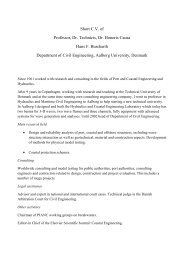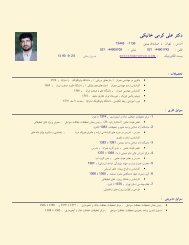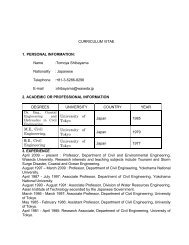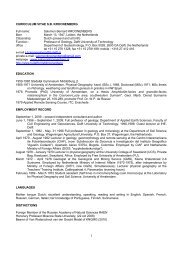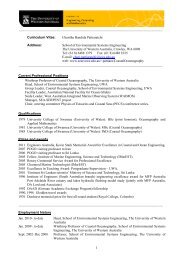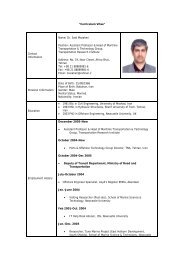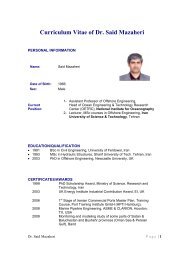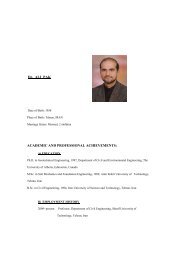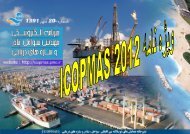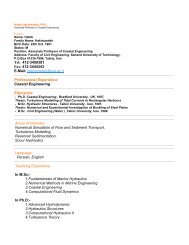Michael J. Risk Condensed Curriculum Vitae Born: Toronto Ontario ...
Michael J. Risk Condensed Curriculum Vitae Born: Toronto Ontario ...
Michael J. Risk Condensed Curriculum Vitae Born: Toronto Ontario ...
Create successful ePaper yourself
Turn your PDF publications into a flip-book with our unique Google optimized e-Paper software.
<strong>Michael</strong> J. <strong>Risk</strong><br />
<strong>Condensed</strong> <strong>Curriculum</strong> <strong>Vitae</strong><br />
<strong>Born</strong>: <strong>Toronto</strong> <strong>Ontario</strong>, Canadian citizen<br />
Married, no dependents<br />
Language skills: English (mother tongue), French, Spanish, Indonesian, some Swahili and<br />
German.<br />
Educational History:<br />
BSc 1962, Honours Geology, University of <strong>Toronto</strong><br />
MSc 1964, Sedimentology, Univ. Western <strong>Ontario</strong><br />
PhD 1970, Marine Biology, Univ. Southern Calif.<br />
Employment History:<br />
General<br />
1960 Junior Geologist, Shell Oil, northern BC<br />
1961 Geologist, Texaco, northern BC/Alberta<br />
1961-1970 TA/RA, UWO/USC<br />
Academic<br />
1971-2003 Professor of Geology and Biology, McMaster Univ.<br />
(accelerated promotions to Assoc. and Full Prof.)<br />
Visiting faculty, various years:<br />
Univ. Costa Rica<br />
James Cook Univ., Australia<br />
Universitas Diponegoro, Indonesia<br />
Univ. Autonoma de Baja California, Mexico<br />
Adjunct appointments<br />
Univ. Puerto Rico, Marine Science<br />
Brock Univ., Geology<br />
CICESE, Mexico, Marine Sciences<br />
Univ. of Tanzania, Marine Sciences<br />
Univ. of Guelph, Zoology<br />
Universitas Diponegoro, Indonesia<br />
Dalhousie Univ., Geology<br />
Univ. of Costa Rica, Biology<br />
Present status:<br />
Professor Emeritus (early retirement 2003), with an active research program.<br />
Awards:<br />
NSERC studentship, 1962/65<br />
NSERC Special Studentship, 1965/69<br />
Brant Award (U <strong>Toronto</strong>) academics and athletics<br />
Bickell Award (U <strong>Toronto</strong>) academics<br />
Teaching awards and nominations: UWO, USC, James Cook Univ., McMaster.<br />
Two Best Teacher Awards<br />
Three Best paper Awards (Most recently, Best Paper in Marine Pollution Bulletin for 2009.)<br />
Funding history (major awards only):<br />
Continuously supported by NSERC, 1971-2005 (present level of Discovery Grant $45,000/yr.)
NSERC Strategic Grant, impact of tidal power developments on the benthic ecology of the<br />
Bay of Fundy: $750,000 (1985-88)<br />
NSERC Strategic Grant, Climate records in deep-water corals: $1.5million, 2000-20005<br />
Asian Development Bank (with Canora Canada): COREMAP Indonesia: $3million, 1998<br />
CIDA Canada:<br />
Marine Ecodevelopment, Indonesia, $3million, 1988-98<br />
Coastal research, Zanzibar, $750,000<br />
Coral Reef Research, Maldives, $450,000<br />
Professional activities:<br />
Manuscript Editor, MEPS<br />
Reviewer: a dozen major journals, 8 countries<br />
Proposal reviewer: US EPA, NOAA, NSF, Hawaii, Australia, Denmark, Netherlands, Sweden<br />
Session Chair, many professional meetings<br />
Symposium organizer: 1 st and 3 rd Int. Deepwater coral congresses<br />
Testified to US Congress, march 2002, on deepwater corals<br />
Member, SEFCRI (SouthEast Florida Coral Reef Initiative) Technical Advisory Board<br />
Technical Advisor to CCPAC, Caribbean Climate Change initiative.<br />
Field and research experience:<br />
Worked in 30 countries, lived in seven. Field experience in mountain geology, intertidal and<br />
subtidal benthic ecology, coral reef ecology, coral reef geology, deep-water coral reefs, coastal<br />
zone management and water quality issues. Extensive experience in impacts of land-based<br />
pollution on coral reefs of the Caribbean, Indian Ocean, Persian Gulf and SE Asia. Animalsediment<br />
research in the Arctic, Maritime provinces of Canada, NE USA, Florida, California. Over<br />
the past decade, my major focus has been on coral reef health and recovery, and scientific<br />
methods to assess stress on reefs.<br />
Experienced diver with more than 10,000 dives over a 50-year period. Advanced capability in<br />
underwater still photography and videography.<br />
Consulted on coral reef health, impacts and recovery in Barbados, Grenada, Bahamas, Mexico,<br />
Tanzania, Maldives, Indonesia; reefs and fisheries in Eritrea, Kenya, Indonesia, US Virgin<br />
Islands, Iran, Saudi Arabia.<br />
Published on and supervised research on mangroves, seagrass beds, softbottom communities,<br />
oil spill impacts, impacts of sewage and industrial discharge, and fish habitat/coral reef ecology.<br />
International experience:<br />
Travel and field work in Sri Lanka, Indonesia, Maldives, Thailand, Malaysia, East Africa,<br />
Caribbean (6 countries), Latin America (4 countries), Middle East (3 countries).<br />
Head of a major project in Indonesia: developed curricula, funded and educated university staff,<br />
funded local social and scientific research, organised community outreach groups, took baseline<br />
data on health and environment, supervised research on coral reef health. This project lasted 10<br />
years. It was so successful that 6 other countries and 4 NGO’s gave us money to continue and<br />
expand our work. In the process, we trained at least two dozen Indonesians who now are the<br />
leaders of their university and community. There was a TV special made on the activities of the<br />
project (People of the Reefs, Wildcard Productions). Budget approx. $1.5 million.<br />
Organised the Coral Reef Research Group in Min. Fisheries, Maldives, 1985-90. This group is<br />
still active, doing frontline work, although their field station was severely damaged by the tsunami.<br />
Budget approx. $500,000.
Organised coral reef research at Institute of Marine Sciences, Zanzibar, 1986-91. This work<br />
involved training Institute staff, and selecting for further study abroad, as well as conducting and<br />
supervising research on the status of coral reefs of Zanzibar. Budget approx. $250,000.<br />
Team Leader, COREMAP Technical assistance. COREMAP is a multimillion-dollar (up to $500<br />
million, potentially) soft loan to Indonesia from ADB and WB to help assess the status of<br />
Indonesia’s coral reefs (Coral Reef Monitoring and Assessment Project). I was in charge of a<br />
major economic and scientific analysis of western Indonesia, including many of the sites<br />
devastated by the recent tsumani. My team scoped out alternative income possibilities, smallbusiness<br />
loans, fisheries impacts and coral reef health. Budget was approx. $3 million.<br />
Currently (2009-2012) head of an international team investigating ecological recovery of Saudi<br />
Arabian intertidal habitats from the oil spill produced during Gulf War I. The entire project is<br />
funded by UNCC, and has a total budget of approx. $1 billion.<br />
Using the technique of determining past environmental conditions via analysis of bioindicatorsbivalve<br />
shells, skeletons of corals, gorgonians, black corals-have successfully concluded major<br />
consulting projects in Iran, Chile, and Saudi Arabia.<br />
Experience specific to Iranian coastlines:<br />
1. Monitoring and modeling study-Phase I, Chabahar.<br />
-field work, sediment analysis, report writing, diving in Chabahar to observe conditions.<br />
2. Monitoring and modeling study-Phase II, Nayband to Dayyer.<br />
-field work, diving in Nayband Bay, technology transfer (sediment analysis), report<br />
writing.<br />
3. Monitoring and modeling study-Phase II, Dayyer to Bushehr and Deylam.<br />
-field work, sediment analysis, shoreline morphology and evolution, report writing.<br />
Iranian ICZM<br />
-advised Iranian experts on aspects of coastal zone management, issues of boundaries<br />
and jurisdiction, indicator species.<br />
4. South Pars Phase 9&10 Dredging Impact assessment.<br />
-field work, observations of corals under sediment stress, preparation of a monitoring<br />
plan to assess sediment levels in water.<br />
5. Keynote Speaker, ICOPMAS 2010.<br />
Publication record (abbreviated):<br />
More than 200 refereed articles and book chapters. Three in Science, two in Nature. Citation<br />
analysis suggests I am in the top-ranked 2% of all scientists, all fields, worldwide: “h” score of<br />
35.<br />
Only publications relevant to this application are listed below (of approx. 200):<br />
<strong>Risk</strong>, M. J., M. Burchell, K. deRoo, R. Nairn, M. Tubrett and G. Forsterra. 2010. Trace elements in<br />
bivalve shells from the Río Cruces, Chile. Aquatic Biology 10: 85-97.<br />
Sherwood, O. A., B. E. Lapointe, M. J. <strong>Risk</strong> and R. E. Jamieson. 2010. Nitrogen isotopic records<br />
of terrestrial pollution encoded in Floridian and Bahamian gorgonian corals. Environ. Sci.<br />
Technol. 44: 874-880.
<strong>Risk</strong>, M. J., O. A. Sherwood, R. Nairn and C. Gibbons. 2009. Tracking the record of sewage<br />
discharge off Jeddah, Saudi Arabia, since 1950, using stable isotopic records from<br />
antipatharians. Mar. Ecol. Progress Series 397: 219-226.<br />
<strong>Risk</strong>, M. J., B. E. Lapointe, O. A. Sherwood and B. J. Bedford. 2009. The use of δ 15 N in assessing<br />
sewage stress on coral reefs. Mar. Poll. Bull. 58: 793-802.<br />
(*awarded Best Paper of 2009.)<br />
<strong>Risk</strong>, M. J. 2009. Editorial: The reef crisis and the reef science crisis: nitrogen isotopic ratios as<br />
an objective indicator of stress. Mar. Poll. Bull. 58: 787-788.<br />
Sherwood, O. A., E. N. Edinger, T. P. Guilderson, B. Ghaleb, M. J. <strong>Risk</strong> and D. B. Scott. 2008.<br />
Late Holocene radiocarbon variability in Northwest Atlantic slope waters. Earth Planetary Sci.<br />
Letters 275: 146-153.<br />
Williams, B., M. J. <strong>Risk</strong>, R. Stone, D. Sinclair and B. Ghaleb. 2007. Oceanographic changes the<br />
Gulf of Alaska over the past century recorded in deep-water gorgonian corals. Marine Ecol.<br />
Progress Series 335: 85-94.<br />
Williams, B., M. J. <strong>Risk</strong>. S. W. Ross and K. J. Sulak. 2007. Stable isotope data from deep-water<br />
antipatharians: 400-year records from the southeastern coast of the United States of<br />
America. Bull. Mar. Sci. 81: 437-447.<br />
Sinclair, D. J., B. Williams and M. J. <strong>Risk</strong>. 2006. A biological origin for climate signals in coralstrace<br />
element “vital effects” are ubiquitous in Scleractinian coral skeletons. Geophysical Res.<br />
Letters 33: L17707, doi:10.1029/2006GL027183.<br />
Williams, B., M. J. <strong>Risk</strong>, S. W. Ross and K. J. Sulak. 2006. Deep-water antipatharians: proxies of<br />
environmental change. Geology 34: 773-776.<br />
Ward-Paige C.A., <strong>Risk</strong> M.J., Sherwood O.A. (2005) Reconstruction of nitrogen sources on coral<br />
reefs: δ 13 C and δ 15 N in gorgonians from the Florida Reef Tract. Marine Ecology Progress<br />
Series (in press).<br />
Ward-Paige C.A., <strong>Risk</strong> M.J., Sherwood O.A. and Jaap, W.C. (2005) Clionid sponge surveys on<br />
the Florida reef tract suggest land-based nutrient inputs. Marine Pollution Bulletin (in press)<br />
Schleyer, M.H., J. M. Heikoop and M. J. <strong>Risk</strong>. A benthic survey of Aliwal Shoal, South Africa, and<br />
assessment of the effects of wood pulp effluent on the reef. In press, Marine Pollution<br />
Bulletin.<br />
Sherwood O. A, Scott D.B., <strong>Risk</strong> M. J., and Guilderson T.P. 2005. Radiocarbon evidence for<br />
annual growth rings in a deep sea octocoral (Primnoa resedaeformis). Marine Ecology<br />
Progress Series 301: 129-134.<br />
Williams, B., <strong>Risk</strong>, M.J., Ross, S., & Sulak, K. (2005) Black coral: a proxy of biogeochemistry off<br />
the SE US continental shelf. Halifax 2005. Joint meeting of Geological Association of<br />
Canada, the Mineralogical Association of Canada, the Canadian Society of Petroleum<br />
Geologists and the Canadian Society of Soil Sciences. Halifax, Nova Scotia<br />
<strong>Risk</strong>, M.J., Heikoop, J.M., Edinger, E.N., Erdmann, M.V., 2001. The assessment "toolbox":<br />
community-based reef evaluation methods coupled with geochemical techniques to identify<br />
sources of stress. Bulletin of Marine Science, 69(2):443-458.<br />
Dibajnia, M., Sanchez, C., Martinez, M., Lara, A., Nairn, R.B., Marván, F. G., Fournier, C.F. and<br />
<strong>Risk</strong>, M., (2004). Why are Cancun beaches eroding, A question of integrated coastal zone
management, Proceedings of XIII Congreso Panamericano de Ingenieria Oceanicay Costera,<br />
Mexico.<br />
.<br />
Takarina, N., D. R. Browne and M. J. <strong>Risk</strong>. 2004. Speciation of heavy metals in coastal sediments<br />
of Semarang, Indonesia. Marine Pollution Bull. 49: 861-868.<br />
Williams, B., <strong>Risk</strong>, M.J., & Stone, R. (2004) A Century of Surface Productivity Recorded in the<br />
Skeleton of a Deep-Sea Gorgonian. AGU Fall Meeting. San Francisco, California.<br />
<strong>Risk</strong> M. J., Sherwood O. A., Heikoop J. M., Llewellyn G. (2003) Smoke signals from corals:<br />
isotopic signature of the 1997 Indonesian ‘haze’ event. Marine Geology 202: 71-78.<br />
Hovland, M., M. <strong>Risk</strong>. 2003. Do Norwegian deep-water coral reefs rely on seeping fluids Marine<br />
Geology 198: 83-96.<br />
Edinger, E.N., Copper, P., <strong>Risk</strong>, M.J., Atmojo, W., 2002. Oceanography, sedimentology, and<br />
reefs of epeiric seas: the Java Sea compared with the Devonian Appalachian Basin and<br />
Michigan Basin. Facies 47(2):127-150.<br />
Lescinsky, H.L., Edinger, E.N., <strong>Risk</strong>, M.J., 2002. Mollusc shell encrustation and bioerosion rates<br />
in a modern epeiric sea: taphonomy experiments in the Java Sea, Indonesia. Palaios 17(2):<br />
170-190.<br />
Edinger, E.N., Kolasa, J., <strong>Risk</strong>, M.J., 2000. Variation in within-site coral species diversity on coral<br />
reefs in three regions of Indonesia. Diversity and Distributions 6: 113-127.<br />
Edinger, E.N., Limmon, G.V., Jompa, J., Widjatmoko, W., Heikoop, J.M., <strong>Risk</strong>, M.J., 2000.<br />
Normal coral growth rates on dying reefs: are coral growth rates good indicators of reef<br />
health Marine Pollution Bulletin 40: 404-425.<br />
Holmes, K.E., Edinger, E.N., Hariyadi, Limmon, G.V., <strong>Risk</strong>, M.J., 2000. Bioerosion of live massive<br />
corals and branching coral rubble on Indonesian coral reefs. Marine Pollution Bulletin 40:<br />
606-617.<br />
Heikoop, J.M., <strong>Risk</strong>, M.J., Lazier, A.V., Edinger, E.N., Jompa, J., Limmon, G.V., Dunn, J.J.,<br />
Browne, D.R., Schwarcz, H.P., 2000. Nitrogen-15 Signals of Anthropogenic Nutrient Loading<br />
in Reef Corals. Marine Pollution Bulletin 40: 628-636.<br />
Edinger, E.N., <strong>Risk</strong>, M.J., 1999. Reef classification by coral morphology predicts coral reef<br />
conservation value. Biological Conservation 92:1-13.<br />
Edinger, E.N., Jompa, J., Limmon, G.V., Widjatmoko, W., <strong>Risk</strong>, M.J., 1998. Reef degradation and<br />
coral biodiversity in Indonesia: effects of land-based sources of pollution, destructive fishing<br />
practices, and changes over time. Marine Pollution Bulletin 36: 617-630.<br />
Edinger, E.N., <strong>Risk</strong>, M.J., 2000. Effects of land-based pollution on Central Java coral reefs.<br />
Journal of Coastal Development 3(2): 593-613.<br />
<strong>Risk</strong>, M. J. 1999. Paradise lost: how marine science failed the world.s coral reefs. Marine<br />
Freshwater Res. 50: 831-837.<br />
Edinger, E.N., Jompa, J., Limmon, G.V., Widjatmoko, W., <strong>Risk</strong>, M.J., 1999. Reef degradation,<br />
coral biodiversity, and reef management in Indonesia. Pesisir dan Lautan 2(2): 1-16.<br />
LeBlanc, C. G., R. A. Bourbonniere, H. P. Schwarcz and M. J. <strong>Risk</strong>. 1989. Carbon isotopes and<br />
fatty acids analysis of the sediments of Negro Harbour, Nova Scotia. Estuarine, Coastal and<br />
Shelf Science 28: 261-276.
<strong>Risk</strong>, M. J., P. W. Sammarco and H. P. Schwarcz. 1994. Cross-continental trends in δ 13 C in coral<br />
on the Great Barrier Reef. Marine Ecology Progress Series 106: 121-130.<br />
Bachtiar, T., J. P. Coakley and M. J. <strong>Risk</strong>. 1999. Tracing sewage-contaminated sediments in<br />
Hamilton Harbour using selected geochemical tracers. The Science of the Total Environment<br />
179: 3-16.<br />
Smith, J.E., <strong>Risk</strong>, M.J., Schwarz, H.P., and McConnaughey, T.A. (1997) Rapid climate change in<br />
the North Atlantic during the younger Dryas recorded by deep-sea corals. Nature 386: 818 –<br />
820.<br />
<strong>Risk</strong>, M. J. and A. C. <strong>Risk</strong>. 1997. Reef surveys as an aid in management. Proc. 8 th Int. Coral Reef<br />
Symp. 2: 1471-1474.Edinger, E. N. and M. J. <strong>Risk</strong>. 2000. Reef classification by coral<br />
morphology predicts coral reef conservation value. Biological conservation 92: 1-13.<br />
Heikoop, J. M., M. J. <strong>Risk</strong>, A. V. Lazier, E. N. Edinger, J. Jompa, G. V. Limmon, J. J. Dunn, D. R.<br />
Browne and H. P. Schwarcz. 2000. Nitrogen-15 signals of anthropogenic nutrient loading in<br />
reef corals. Marine Poll. Bull. 40: 628-636.



